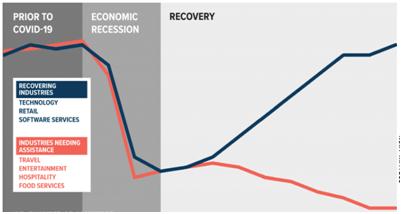What is a K-shaped economic recovery and what are its implications?
- Posted By
10Pointer
- Categories
Economy
- Published
11th Jan, 2021
-
Context
- The prospects of a K-shaped recovery from COVID are increasing both in India and across the world.
What is a K-shaped recovery?
- A K-shaped recovery happens when different sections of an economy recover at starkly different rates.
- The “K-shaped” economic recovery is characterised by a stark split in the recovery pace of the economy— some sectors are bouncing back ahead of the rest at a much faster pace, while others are continuing a downward trajectory.
- The industries that are on the upper curve and may bounce back faster are technology plays, large corporations, governments, and public utilities.
- While industries on the lower curve, who are suffering the fallout from the COVID-19 pandemic, are the travel, entertainment, hospitality and food services industries.

What are the macro implications of a K-shaped recovery?
- Upper-income households-The top 10 per cent of India’s households are responsible for 25-30 per cent of total consumption.Upper-income households have benefitted from higher savings for two quarters. This section could be beneficial for the recovery.
- Lower income groups- To the extent that households at the bottom have experienced a permanent loss of income in the forms of jobs and wage cuts, this will be a recurring drag on demand, if the labour market does not heal faster.
- Expenditure-To the extent that COVID has triggered an effective income transfer from the poor to the rich, this will be demand-impeding because the poor have a higher marginal propensity to consume (they tend to spend instead of saving) a much higher proportion of their income.
- Disparity among nations- If COVID-19 reduces competition or increases the inequality of incomes and opportunities, it could impinge on trend growth in developing economies by hurting productivity and tightening political economy constraints.
